Building automation evolution continues

The capabilities of building automation systems (BASs) continue to evolve and expand, providing hospitals with additional tools to improve facilities management. Hallmarks include integration with other building systems, data collection and analysis, and the use of mobile devices.
In recent years, there has been a drastic shift in expectations of BAS functionality and capability. From simple HVAC controls and automation, BASs today offer extensive capabilities through integration with other systems within health care environments.
“These include real-time location systems, power and energy management, surgical scheduling and nurse call, life safety and physical security, infection control and hand hygiene,” says Alex Yashkevich, portfolio head for health care and industrial vertical markets at Siemens Smart Infrastructure USA, Buffalo Grove, Ill.
As the use of mobile devices increases, BAS providers have seen greater demand for mobile access to building automation technology that allows for monitoring and maintenance, even on the go.
“Cloud technology has enabled this mobile access, which can improve the efficiency of building management, particularly if the data transmitted is utilized to gain deeper insights on building use and needs,” says Jana Gerber, vice president of building segments at Schneider Electric, Andover, Mass.
Integral to business
BASs are now integral to core hospital operations, including compliance reporting, dashboards and 24/7 monitoring, according to Kurt Carpenter, portfolio leader at Trane, Davidson, N.C.
“For example, Trane provides dashboards at the operating room nurses station to show that a room is in compliance before the patient is wheeled in,” Carpenter says. “These dashboards also show overrides that allow nurses to set back air changes when the rooms are not in use. Integrated systems automatically create work orders when a space is out of compliance.”
By their very nature, hospitals pose challenges to BAS providers. Outdated infrastructure is one issue. Many hospitals are old. Lack of a network infrastructure, sealed ductwork and a building envelope can make it difficult to implement efficient automation.
Building controls in hospitals often reflect their construction history. “Different wings may have different controls systems with no coordinated plan or standardization,” Carpenter says. “Many hospitals have inefficient HVAC systems such as constant-volume-reheat and dual-duct systems with a mixture of BAS components and a high installation base of pneumatic controls.”
Cybersecurity is another key issue in health care facilities management. “Typically, the BAS server and its internet protocol (IP) components have been siloed from the greater information technology (IT) infrastructure due to security concerns over open, nonencrypted protocols,” says Mead Rusert, president of Automated Logic Corp., Kennesaw, Ga. “BAS providers are moving toward an IT-friendly and secure protocol of BACnet Secure Connect, which encrypts communication to the latest industry standards.”
Smaller, off-site health care facilities pose their own set of challenges. Some satellite sites may not have a BAS and, if they do, it may not be connected to, or compatible with, the central facilities’ BAS. “Even with a BAS connected to the central site, satellite sites rarely have dedicated staff that can put BAS capabilities and data to meaningful use,” says Corey Rinehimer, head of marketing at Alerton, Lynnwood, Wash.
Many hospitals and off-site facilities are setting up a hub-and-spoke model, so that the main hospital and smaller facilities (within a certain radius) are served by the same maintenance team. “With the help of connected devices and cloud-based solutions, this model helps the wider team better understand the use — and misuse — of the buildings, anticipate when issues arise, and gain a complete view across the portfolio of buildings,” Gerber says.
Collecting vital data
Data collection from BASs is vital and represents a great opportunity for the health care community to drive better outcomes. From real-time, in-room monitoring that is used to inform in-the-moment decisions to compliance reporting to advanced analytics that drive future building operation strategies, data is at the core of a comprehensive facility strategy.
“The role of the BAS is to ensure access to data, provide robust analytics tools that can process data points, and synthesize that data via artificial intelligence (AI) and machine learning to create strategies that improve the safety and comfort of patients and staff,” Rinehimer says.
BASs provide useful information from high-traffic areas and occupied spaces, and insight into how systems are operating to deliver the desired outcomes, according to Julie Brown, institutional market leader at Johnson Controls, Milwaukee.
“For example, areas such as the emergency room, cafeteria and lobby tend to experience the highest occupancy levels at any given time,” Brown says. “BASs are capable of understanding when areas are occupied and automatically switching modes to deliver safe environmental conditions. HVAC performance improves, allowing greater ventilation, filtration and disinfection to reduce the risk of disease spread.”
The data collection from BASs can provide information for further decision making. “For example, a building’s HVAC system consumes up to 40% of its total energy use,” Yashkevich says. “Collecting the right data — such cooling and heating behavior trends, fuel consumption, predictive fault detection and diagnostics — can help health facility managers develop better sustainability strategies and efficient operational practices.”
Innovative features
The latest BAS introductions to the health care field incorporate many of these features. For example, Alerton’s Patient Safety Solution (PSS) provides a scalable and flexible approach to facilities management at the campus, building and room level. PSS integrates key health care systems into a single management interface and is built to scale with features such as IP version 6 support and intuitive operator tools that allow the system to grow as new innovations come to market.
“PSS is built to drive data-centric management of the facility; it features a compliance reporting suite and AI-driven continuous learning to inform and optimize future performance,” Rinehimer says. At the individual space level, PSS can be tailored to room type. It can create hybrid use rooms, capture multiple environmental parameters, provide real-time feedback on room conditions, and allow staff and patients to make adjustments and requests from in-room monitors via personal devices or with voice commands.
Johnson Controls has released Flexible Controls, a cloud-based technology solution that utilizes preconfigured building control sequences optimized for normal, pandemic and other emergency operations. This integrated user interface allows for on-site and remote monitoring of systems to optimize facility operations. Its standard automated control sequences help reduce risk by allowing quick changing of building operating modes.
As a result, Flexible Controls improves infection control. “Operating with a number of factors, such as the size of a space, number of sick individuals and the type of virus, disease or emergency event, it automatically leverages HVAC equipment and controls to provide cleaner air — bringing in disinfected, filtered and outdoor air,” Brown says.
Trane has added features to its Tracer Ensemble BMS, which include automated compliance reporting and customizable dashboards to help visualize data at the portfolio, building, system and room level. Tracer Ensemble BMS also offers tailored interfaces for all levels of users throughout the system, instead of a one-user-interface-fits-all approach.
“We just introduced our work order management solution built directly into our BAS, which provides productivity improvements and new insights,” Carpenter says. “Also, our new facility scheduling solution is ideal for managing smaller health care facilities.”
All Trane BASs are designed around the BACnet standard and fully expose all of the data in the BAS to improve the integration of systems across the health care ecosystem. They also expose the data for advanced analytics and 24/7 monitoring. “Trane is expanding its cloud solution offerings, which include building and energy analytics, grid services and demand management, predictive maintenance and responsive controls,” Carpenter says.
Join together
EcoStruxure for Healthcare from Schneider Electric can help hospital facility managers navigate the complexities of IT and operational technology convergence and implement a cybersecurity strategy that fuses the needs of both realms. Its integrated control platform brings a variety of building subsets into one intelligent control system. “EcoStruxure, our smart building platform and open system architecture, allows hospitals to interact, share data and develop apps, increasing efficiency by 30% and ensuring comfort for occupants,” Gerber says.
In addition, the connected room solution, part of the EcoStruxure Building portfolio, provides room-level interfaces for HVAC and lighting control in addition to a single point of integration for other IoT devices in a room. “This modular approach enables hospitals to select only the applications they need, making the configuration more cost-effective and efficient,” Gerber says.
The latest generation of BASs from Siemens is based on open-platform IP communication technology and developed with computing power in mind, which requires no human interaction under normal operational routines. “In addition, BASs from Siemens can be scaled to any application requirements and are vendor-agnostic when it comes to third party system integrations,” Yashkevich says.
Automated Logic is working with the nonprofit Powered for Patients, Washington, D.C., to develop a dashboard that addresses the challenges associated with providing real-time status reports for emergency power supply systems in health care facilities. The dashboard harnesses the power of the company’s WebCTRL BAS and allows utilities to quickly see the status of unfolding threats to emergency power. “The dashboard synthesizes status reports from the WebCTRL system’s fault detection and diagnostic (FDD) capabilities, along with similar data streams from other technology providers, into a single data stream to populate the online dashboard with red, yellow or green threat-level indicators,” Rusert says.
The built-in FDD capabilities of the WebCTRL system allow facility managers to identify and respond to issues before they occur. Automated analytic tools can help uncover potential problems in HVAC and electrical equipment, enabling corrective action before system performance is compromised during a crisis such as a hurricane or other weather event.
Distech Controls Inc., Montreal, has introduced the “my Personify” mobile app, which allows customization of comfort settings directly from a mobile device. It connects via Bluetooth low energy (BLE) technology to any BLE-enabled room device that is compatible with the company’s technologies. Featuring an intuitive interface, the mobile app allows patients to set room comfort parameters to their personal preferences from a single location.
“The my Personify mobile app integrates the control of comfort functions into spaces for occupants. Setup can be completed in minutes with preconfigured programming or the option to use the software development kit to design one’s own interface to implement specific needs,” says Joel Desire, connected building solution manager at Distech Controls, a subsidiary of Acuity Brands Lighting Inc.
Looking ahead
Leveraging multiple building systems to a single platform and data lake is the ultimate goal for future BAS enhancement, according to Rusert. “How the data is collected (on premise or in the cloud) and how the data is analyzed to develop insights for hospital staff will be the key,” he says. “This is an evolving initiative, with many BAS providers involved.”
Additionally, improved response to current events and increasing flexibility is critical to the future of BASs in hospitals, according to Brown. “The COVID-19 pandemic taught us valuable lessons on how to prepare buildings for future conditions, such as health emergencies and natural disasters,” she says. “Pandemic modes and normal modes that can switch on command will continue to advance. Critical building systems also will be modernized to adapt to new requirements and standards.”
Neal Lorenzi is a freelance writer and regular contributor based in Mundelein, Ill.
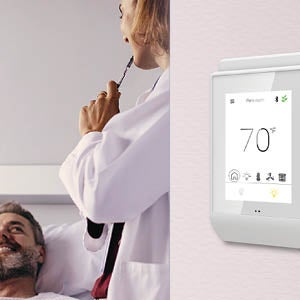
GOING MOBILE
The Eclypse SDK thermostat integrates the control of room comfort functions into a mobile app. Distech Controls Inc.

IMPROVED INTEGRATION
EcoStruxure Building is an open and secure building management platform that integrates multiple systems for centralized, real-time control and management across one to many health care facilities. Schneider Electric
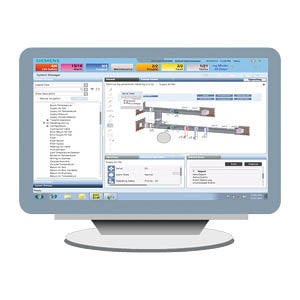
CRITICAL MISSION
Desigo CC is a comprehensive building management platform capable of integrating a wide range of mission-critical systems. Siemens Smart Infrastructure USA
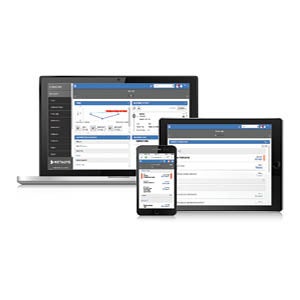
ALWAYS OPERATIONAL
The Flexible Controls solution utilizes Metasys Building Automation Software to provide an integrated user interface and standard control sequences to optimize facility operations under normal and emergency conditions. Johnson Controls
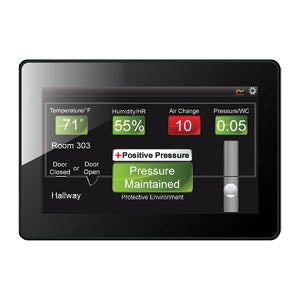
AIR AWARENESS
The OptiPoint indoor air quality display shows a hospital’s operating room pressure. Automated Logic Corp.
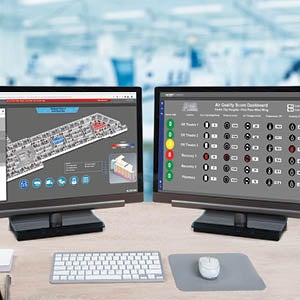
COMPLETE CONTROL
his health care suite, anchored by Compass, allows users to manage an entire health care facility ecosystem from an integrated control center. Alerton




